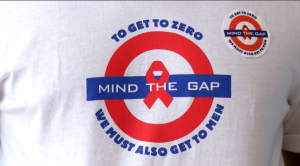Mind the Gap: Engaging Young Men and Boys in Getting to Zero
By Remmy Shawa, Sonke Gender Justice and Lindsay Menard-Freeman, Women Deliver
 Throughout the session rooms of this 17th ICASA, it’s clear that gender inequality is a key driver of HIV in Africa. Gender-based violence, harmful practices against girls (like child marriage and female genital cutting) and violence against women in key affected populations all increase risk for HIV infection. In addition, HIV risk is closely connected to stigma, discrimination and blame for women, particularly women living with HIV and women who experience violence. But how can the HIV response encourage men to challenge gender inequality to get to Zero?
Throughout the session rooms of this 17th ICASA, it’s clear that gender inequality is a key driver of HIV in Africa. Gender-based violence, harmful practices against girls (like child marriage and female genital cutting) and violence against women in key affected populations all increase risk for HIV infection. In addition, HIV risk is closely connected to stigma, discrimination and blame for women, particularly women living with HIV and women who experience violence. But how can the HIV response encourage men to challenge gender inequality to get to Zero?
These conversations about inequality focus on women, and rightfully so. Women are at the center of the epidemic, especially in Africa. And young women between the ages of 15 and 24 are two times more likely to become infected with HIV than young men in the same age group. In South Africa specifically, HIV prevalence is also much higher among women (23%) in men (13%).
But there are health outcomes to consider when looking at opportunities to engage men and boys in HIV and STI prevention. There is low uptake of HIV services by men and boys, and low HIV testing rates and utilization of treatment on the part of men and boys. According to studies from the University of Cape Town, men living with HIV are starting ART with more advanced HIV viral load and are more likely than women to interrupt treatment or get lost in follow up.
These barriers to services range from structural to social and cultural. For instance, illness is often considered a sign of weakness and makes men less likely to seek early interventions. Men are not being reached, and there’s a crucial gap between the health needs and health behaviours of men. And this is a gap that must be bridged by gender transformative strategies to get to Zero.
We get to Zero by redefining the norms around masculinity, and supporting health policies that are gender equitable and transformative. Health system must be more relevant to men and boys, engaging them as clients to increase service utilization. Programs to encourage men to support their partners and serve as change agents are crucial to challenging violence. And curbing gender-based violence, which is largely experienced by women, will reduce HIV risk for all.
We have an opportunity to shift the gender paradigm to one that involves men in conversation that transforms harmful norms, and we can start with young men. If norms are socially constructed to promote violence and gender inequality, can’t they be reversed? We say they can, and young men can play a critical role in this effort.
It’s about getting to Zero new HIV infections. It’s about preventing AIDS-related deaths and increasing access to treatment for people living with HIV. But it’s also about constructing a world where men and women, girls and boys are equal, and can live healthy lives with ready access to their rights. One of the ways to make Zero a reality is to engage young men and boys.
Remmy Shawa is the International Sida Project Coordinator for the Sonke Gender Justice Network, a South Africa-based non-profit that focuses on gender equality, gender-based violence prevention and HIV/AIDS, and one of the Women Deliver 100 Young Leaders. Lindsay Menard-Freeman is the Advocacy & Communications Manager at Women Deliver, and has worked on young people’s access to sexual and reproductive health and rights for nearly a decade.
You can find Remmy on Twitter at @HonShour and Lindsay on Twitter as @lindsmf


